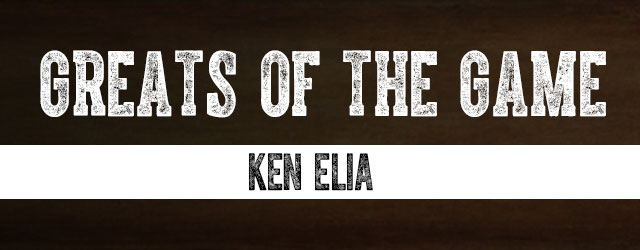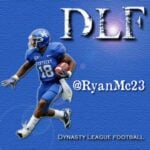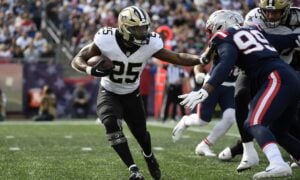Greats of the Game: Ken Elia

I play in way too many dynasty leagues. There…I said it! Managing over a dozen dynasty teams certainly can be a burden at times, but that’s for another article. One of the huge benefits I’ve found of playing in so many leagues and against so many other dynasty players is the exposure I’ve had to a variety of approaches to building, managing and adjusting a dynasty roster.
I don’t think this needs to be said, but just in case, I want to make this clear. Writing for an excellent site like Dynasty League Football, or any other prestigious fantasy site does not make us special. It doesn’t automatically give us some great all-knowing fantasy prowess that we can hold over those non-writers. Like I said, that’s obvious.
I’m lucky enough to play in leagues with fantasy writers from all different sites and some of the most well known names in the industry, but those aren’t always the ones who are winning the league. In fact, some of the best and most successful players in my leagues are people you may have never heard of, or fantasy writers who don’t always get the credit they deserve.
Ten years ago, I began a series of dynasty leagues called the HyperActive leagues and they have grown far beyond my expectations. I recently questioned four participants and past champions of the HyperActive leagues about what exactly it is that has made them so successful in these, and other dynasty leagues. While exact record keeping of the leagues has not been my strong suit, I feel very confident in saying these four are among the elite dynasty players I have come across in this hobby and I consider them among the Greats in the Game!
I asked each of the four the same questions and, while they all deserve plenty of praise and credit, this article is meant to be more of a learning tool about the varying strategies that have led to their success rather than personal profiles.
In this edition, I exchanged emails with Ken Elia, one of the founding members of the HyperActive dynasty leagues. Ken now plays in all five of the original HyperActive leagues, and has a large collection of league championships to his credit. While Ken does not write for any fantasy site, he’s one of the most competitive dynasty players I’ve faced.
DLF: How would you describe your general dynasty mindset or strategy?
KE: My overall goal is to build a balanced team that will be competitive every season. I want to roster a mix of established producers and enough younger prospects to replace my veterans in a year or two if need be. My first objective is to have impact players at every position in my starting lineup.
DLF: What is your typical plan of attack in a dynasty startup draft?
KE: Before the draft, I want to position myself to have the most picks possible in the first 50 picks. If I’m lucky enough to draw an early draft position I will always try to trade down in the 1st round to improve my 2nd and 5th, 6th, or 7th round picks.
Because I play in PPR leagues with three or four flex spots, my draft plan almost always includes taking two of the best wide receivers possible in the first three rounds. I’ll usually wait until the 3rd round to draft my RB1. I also look to take my WR3 in the 4th round and my RB2 in the 5th unless one of the top quarterbacks are still on the board.
In rounds 6 and 7 I typically look at quarterback and tight end. After I have all of my starters in place I begin looking for my bye-week players and future prospects. I’m always looking for quality starters that have slipped down in the draft.
DLF: What advice would you give to other dynasty players when it comes to making trades in dynasty leagues?
KE: Trades are important to the success of your team. Having said that, I see too many dynasty GMs that are eager to trade just for the thrill of trading. A trade should make sense for your team. I constantly evaluate my roster and lineups against other teams to see if I should upgrade a particular position to become more competitive and I like to trade, but only if making a deal makes sense.
[inlinead]Another thing that influences my trading is my teams’ composition. If my team is very competitive but features a lot of older veterans, I may be more willing to trade for another vet that could put me over the top this year. If I’m rebuilding, I may be less likely to trade for an older vet that won’t be around by the time my team becomes competitive.
I always try to make a fair opening offer so I can obtain my potential trade partner’s interest. I consider the other teams’ needs and try to include players or picks that the other owner might be interested. I try to keep an open mind about trades. It’s fun and interesting to see how creative I can be to facilitate a deal.
DLF: What is unique about how you manage the “day to day” operations of your dynasty teams?
KE: I don’t know that it’s unique but I think it’s important to keep up with the NFL every day. I spend at least 30-45 minutes reading about NFL players and teams, especially during the off-season. Keeping informed helps me make the best personnel decisions for my team. Most recently, I spent a lot of my time preparing for the upcoming NFL rookie draft since most of the eight dynasty leagues I participate in will hold their rookie drafts shortly thereafter.
DLF: What is a strategy you use in any aspect of dynasty fantasy leagues that you would recommend to all dynasty players?
KE: I really feel that it’s important to have good trade discipline. That means not overpaying for any one player (or at least recognizing that you’re overpaying but feel that the overpay is worth the potential reward). Before I make any trade I need to feel comfortable that the deal makes sense for my team. It sounds like a simple rule but sometimes tougher to follow than it would seem.
Another aspect of good trade discipline is to have a discussion about a player you’re interested in prior to making an offer. Getting a feel for how your potential trade partner values a particular player will tell you if he’s even worth pursuing. If it sounds like you have some common ground, you can try to make a deal. Outside of fantasy football, it has been said that the true sign of a fair deal is when neither side is completely happy.
DLF: What is the one thing that has set you apart and led to your level of success in dynasty leagues?
KE: That has to be preparation. Playing in dynasty leagues takes much more time and commitment than re-draft leagues. I play in highly competitive leagues against knowledgeable and skilled dynasty owners. I’m proud of the fact that most of my teams make it to the playoffs year after year. I attribute this to the time and dedication I put in to prepare for each season. Like DLF says, “There is no off-season.”
Takeaways
I love Ken’s old school approach to team building. As he described his approach of filling his starting lineup before focusing on depth and youth, my default response was to disagree, but recalling the success Ken has enjoyed as a result of this tactic quickly reminded me that there is more than one way to win in dynasty.
Ken’s explanation of his trade discipline also hit home, and I’ve seen this in action many times. Ken is a tough trade partner, but the deals he makes almost always work out for him. That doesn’t mean he’s intentionally ripping off unsuspecting owners, but rather he puts in the time to ensure all deals he makes are right for his team.
[ad5]
- Monday Mocks: 2024 Landing Spots - April 15, 2024
- Five Landing Spots That Would Tank Rookie WR Value - April 13, 2024
- Monday Mocks: 2024 Backup Quarterbacks - April 8, 2024


































































